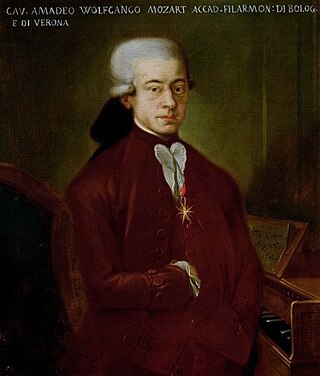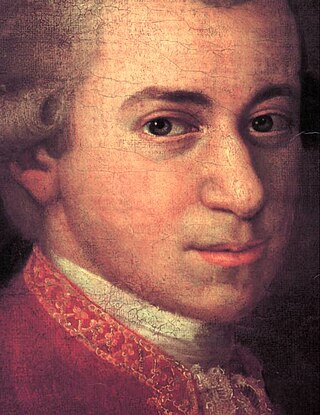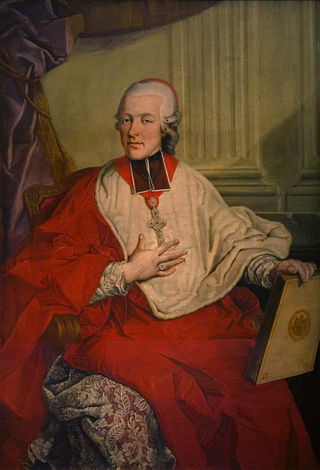
The Symphony No. 36 in C major, K. 425, also known as the Linz Symphony, was written by Wolfgang Amadeus Mozart during a stopover in the Austrian town of Linz on his and his wife's way back home to Vienna from Salzburg in late 1783. The entire symphony was written in four days to accommodate the local count's announcement, upon hearing of the Mozarts' arrival in Linz, of a concert. The première in Linz took place on 4 November 1783. The composition was also premièred in Vienna on 1 April 1784. The autograph score of the "Linz Symphony" was not preserved, but a set of parts sold by Mozart to the Fürstenberg court at Donaueschingen in 1786 does survive.

The Bassoon Concerto in B-flat major, K. 191/186e, is a bassoon concerto written in 1774 by Wolfgang Amadeus Mozart. It is the most often performed and studied piece in the entire bassoon repertory. Nearly all professional bassoonists will perform the piece at some stage in their career, and it is probably the most commonly requested piece in orchestral auditions – it is usually requested that the player perform excerpts from the concerto's first two movements in every audition.

The Symphony No. 29 in A major, K. 201/186a, was completed by Wolfgang Amadeus Mozart on 6 April 1774. It is, along with Symphony No. 25, one of his better known early symphonies. Stanley Sadie characterizes it as "a landmark ... personal in tone, indeed perhaps more individual in its combination of an intimate, chamber music style with a still fiery and impulsive manner."

The Violin Concerto No. 5 in A major, K. 219, often referred to by the nickname "Turkish", was written by Wolfgang Amadeus Mozart in 1775, premiering during the Christmas season that year in Salzburg. It follows the typical fast–slow–fast musical structure.

Wolfgang Amadeus Mozart's Piano Sonata No. 8 in A minor, K. 310 / 300d, was written in 1778. The sonata is the first of only two Mozart piano sonatas in a minor key. It was composed in the summer of 1778 around the time of his mother's death, one of the most tragic times of his life.
The Divertimento in E♭ major, K. 563, is a string trio, written by Wolfgang Amadeus Mozart in 1788, the year in which he completed his last three symphonies and his "Coronation" Piano Concerto. It is his last divertimento and different from his other divertimenti not only in its instrumentation but also in its compositorial ambition and scope.

The Serenade No. 10 for winds in B-flat major, K. 361/370a, is a serenade by Wolfgang Amadeus Mozart scored for thirteen instruments: twelve winds and string bass. The piece was composed in 1781 and is often known by the subtitle Gran Partita, though the title is a misspelling and not in Mozart's hand. It consists of seven movements.
The Serenade for orchestra in D major, K. 250 (248b), popularly known as the Haffner Serenade, is a serenade by Wolfgang Amadeus Mozart named for the Haffner family. Mozart's friend and contemporary Sigmund Haffner the Younger commissioned the serenade to be used in the course of the festivities before the wedding of his sister Marie Elisabeth Haffner and her intended, Franz Xaver Spaeth. The Serenade was first played on 21 July 1776, on the eve of the wedding. It is in eight movements:

The Piano Concerto No. 8 in C major, K. 246, or Lützow Concert was written by Wolfgang Amadeus Mozart in April 1776 in the same year as the Haffner Serenade. Countess Antonia Lützow, who was 25 or 26 years old at the time, was the second wife of Johann Nepomuk Gottfried Graf Lützow, the Commander of the Hohensalzburg Fortress. She was a fine pianist. The solo work is not highly demanding, but it requires agility. Mozart played the concerto in Mannheim and Munich on October 4, 1777, and used it for teaching. Three cadenzas by Mozart have survived. Kitano concludes that the first two cadenzas, A and B in the Urtext edition, may have been written for the Countess Lützow herself to accommodate her limited technical ability, while cadenza C more resembles what Mozart might have played when he performed the work in Augsburg in 1777.
Sonata for Piano and Violin No. 21 in E minor is a work by Wolfgang Amadeus Mozart. It was composed in 1778 while Mozart was in Paris. The piece was composed during the same period that Mozart's mother, Anna Maria Mozart, died, and the sonata's mood reflects this. It is the only instrumental work by Mozart whose home key is E minor.

Wolfgang Amadeus Mozart's Piano Sonata No. 4 in E-flat major, K. 282 / 189g, (1774) is a sonata in three movements:

The Serenade for Orchestra No. 9 in D major K. 320, Posthorn, was written by Wolfgang Amadeus Mozart in Salzburg, in 1779. The manuscript is dated 3 August 1779 and was intended for the University of Salzburg's "Finalmusik" ceremony that year.
Wolfgang Amadeus Mozart's first four sonatas for keyboard and violin, K. 6–9 are among his earliest works, composed between 1762 and 1764. They encompass several of Mozart's firsts as a composer: for example, his first works incorporating the violin, his first works with more than a single instrument, his first works in more than one movement and his first works in sonata form. In fact, previous to this, all his works had been short solo-pieces for the harpsichord.
Wolfgang Amadeus Mozart composed six sonatas for keyboard with accompaniment of violin and cello, K. 10–15, in late 1764 in London during the Mozart family's grand tour of Europe. Britain's Queen Charlotte commissioned them on 25 October, and the works were dedicated to her on 18 January 1765. They were published as Mozart's "Opus III" by his father Leopold at 20 Frith Street, Soho, London, where the Mozarts lived from September 1764 until after May 1765.
Wolfgang Amadeus Mozart's set of six sonatas for keyboard and violin, K. 26–31 were composed in early 1766 in The Hague during the Mozart family's grand tour of Europe. They were dedicated to Princess Caroline of Nassau-Weilburg on the occasion of the eighteenth birthday of her brother, William V, Prince of Orange. They were published as Mozart's Opus 4.
The Milanese Quartets, K. 155–160, are a set of six string quartets composed by Wolfgang Amadeus Mozart in late 1772 and early 1773 when he was sixteen and seventeen years old. They are called 'Milanese' because Mozart composed them in Milan while he was working on his opera Lucio Silla. Before this set was composed, Mozart had written one earlier string quartet, so these six quartets are numbered from No. 2 to No. 7. The quartets are written in a plan of keys of D–G–C–F–B♭–E♭ following the circle of fourths.
The six string quartets, K. 168–173, were composed by Wolfgang Amadeus Mozart in late 1773 in Vienna. These are popularly known as the Viennese Quartets. Mozart may have hoped to have them published at the time, but they were published only posthumously by Johann André in 1801 as Mozart's Op. 94.
The Serenade No. 5 in D major, K. 204/213a was written on 5 August 1775 by Wolfgang Amadeus Mozart for ceremonies at the University of Salzburg. The work is very similar to the serenade K. 203, composed for Salzburg the previous summer.

The Serenade No. 4 in D major, K. 203/189b was written in August 1774 by Wolfgang Amadeus Mozart for ceremonies at the University of Salzburg. It is nicknamed Colloredo after Mozart's patron, Count Hieronymus von Colloredo. The work is very similar to the serenade K. 204 composed for Salzburg the following summer.
The divertimenti in F major, B-flat major, E-flat major, F major, and B-flat major are five companion compositions for pairs of oboes, horns and bassoons by Wolfgang Amadeus Mozart.






